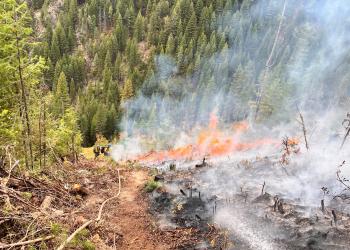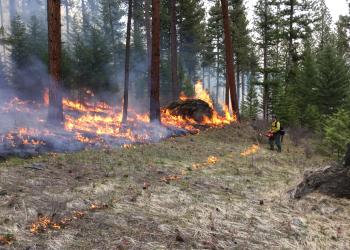Prescribed Fire
Prescribed fire is normally implemented during the fall, winter, or spring, when conditions allow. It is one tool used to promote and maintain a resilient landscape. Follow us on Facebook or InciWeb (search for Lolo National Forest Prescribed Fire Operations) for prescribed fire updates or contact one of the Lolo National Forest Offices.
About the Program

Working to improve the condition of the forest and reduce wildfire risk to communities and first responders is a top priority and core to the conservation and the Forest Service mission. We work hard to use every tool available to promote and sustain a resilient forest. Prescribed fires, often combined with mechanical and/or hand thinning treatments, are effective land management tools frequently used to reduce the accumulation of hazardous fuels, including old and dense vegetation.
Learn About Prescribed Fire
Reduces fuel build-up.
Dead wood, overcrowded, unhealthy trees, and thick layers of pine needles can all contribute to catastrophic wildfires including crown fires.
Prepares the land for new growth.
When excess vegetation or needle layers are burned off, nitrogen and other nutrients are released into the soil and become available for new plants to grow.
Helps certain plants/trees germinate.
Many native plant and forest communities have adapted to fire for their germination and growth. Seed contact with soil (such as that exposed by a fire) is necessary for some species to naturally regenerate.
Naturally thins overcrowded forests.
Historically, natural fire thinned the forests. Thinned forests can recover faster and are more resistant to insect and disease attacks. Currently, many of the mature forests are overcrowded, resulting in a lack of vigor and health.
Creates diversity needed by wildlife.
Fire provides diverse habitat for plants and animals. Grazing wildlife such as Elk and Deer benefit from new growth as shrubs produce edible leaves when re-sprouting after a fire.
Shrub regeneration creates nesting areas for small birds and provides food from flowers and fruit for insects and small mammals.
Check out this video below about the Misconceptions and Benefits of Fire.
Pile Burning: ignition of hand or machine piles of cut vegetation that have been allowed to dry out. Pile burning is commonly used to mitigate wildfire risk in areas where broadcast burning may not be feasible, such as adjacent to communities or private lands. Piles are made from the residual woody debris often left after a mechanical thinning treatment and can range in size from small hand stacked piles to large piles created with mechanical equipment. Piles are typically burned in fall, winter, or early spring after the piles have dried out and conditions allow, reducing the damage to the remaining trees and confining the majority of fire to the footprint of the pile.
Underburning: a type of prescribed fire treatment, that ignites vegetation under the forest canopy and focuses on the consumption of surface fuels
Prescribed fires are carefully planned and implemented in accordance with a written burn plan. Prior to implementation, local fire managers coordinate with local cooperators, counties, and partners. When prescription criteria are met, firefighters implement, monitor, and patrol each burn to ensure it meets forest health and public safety goals. Check out the video below created by our partners at The Nature Conservancy.
All prescribed fires will be implemented in compliance with Montana air quality standards and coordinated with the Montana Department of Environmental Quality and the appropriate county health departments to reduce the impacts of smoke to neighbors, cooperators, and surrounding communities. Smoke may settle in valley bottoms and drainages overnight, but it is expected to dissipate within a few days. Visit the Fire and Smoke Map by AirNow for the current smoke outlook. Daily planned ignitions can be found on line at the Airshed Management System website.
Prescribed fires on the Lolo National Forest are supported through partnerships. Wildlife partnerships assisting with funding burns include Rocky Mountain Elk Foundation, Mule Deer Foundation, National Wild Turkey Federation, and Upland Game Bird Enhancement Group. Cooperator assistance with burning whom we have agreements with to assist us on burns include Montana DNRC, Missoula Rural Fire Department, Frenchtown Rural Fire Department, The Nature Conservancy, and the Bureau of Land Management.
View the different photo Flickr albums below:
- Prescribed Fire Photo Album
- Frenchtown Face Prescribed Fire Photo Album
- Petty Mountain Prescribed Fire Photo Album
- Ninemile Thinning Project Photo Album
Smoke column from prescribed fire.
Additional Resources
Blackfoot Challenge- The Blackfoot Prescribed Fire Work Group supports and increases the use of prescribed fire as a land management, maintenance, and restoration tool across public and private lands in the Blackfoot watershed. Visit the Blackfoot Challenge website for more information.
Landowner/Homeowner Resources- The Montana Department of Natural Resources & Conservation (DNRC) has resources available to manage the urban forest on your property, visit the DNRC website to get start.
Wilderness and Fire

Fire has been present on the North American continent since its beginning, shaping ecosystems and being shaped in turn by the burning practices of people. Over time, the frequency and intensity of fires - what scientists call a fire regime - influenced a landscape’s entire community of life, from plants to animals to people. Some landscapes thrived with frequent low- or moderate-intensity fires while others renewed themselves through infrequent high-intensity burns.












